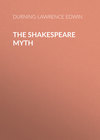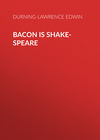Kitobni o'qish: «The Shakespeare Myth»
THE FOLIO OF THE PLAYS, 1623
IT is now universally admitted that the Plays known as Shakespeare's are the greatest "Birth of Time," the most wonderful product of the human mind which the world has ever seen, that they evince the ripest classical scholarship, the most perfect knowledge of Law, and the most intimate acquaintance with all the intricacies of the highest Court life.
The Plays as we know them, appeared in the Folio, published in 1623, seven years after Shakespeare's death in 1616. This volume contains thirty-six plays. Of this number only eight are substantially in the form in which they were printed in Shakespeare's lifetime. Six are greatly improved. Five are practically rewritten, and seventeen are not known to have been printed before Shakespeare's death, although thirteen plays of similar names are registered or in some way referred to.
The following particulars are mainly derived from Reed's "Bacon our Shakespeare," published 1902. The spelling of the first Folio of 1623 has, however, been strictly followed.
THE EIGHT WHICH ARE PRINTED IN THE FOLIO SUBSTANTIALLY AS THEY ORIGINALLY APPEARED IN THE QUARTOS ARE: —
1. Much ado about Nothing.
2. Loves Labour lost.1
3. Midsommer Nights Dreame.
4. The Merchant of Venice.
5. The First part of King Henry the fourth.
6. The Second part of K. Henry the fourth.
7. Romeo and Juliet.
8. The Tragedie of Troylus and Cressida.2
THE SIX WHICH HAVE BEEN GREATLY IMPROVED ARE: —
1. The Life & death of Richard the second. Corrections throughout.
2. The Third part of King Henry the sixt. New title, 906 new lines, and many old lines retouched.
3. The Life & Death of Richard the Third. 193 new lines added, 2,000 lines retouched.
4. Titus Andronicus. One entire new scene added.
5. The Tragedy of Hamlet. Many important additions and omissions.
6. King Lear. 88 new lines, 119 lines retouched.
THE FIVE WHICH HAVE BEEN PRACTICALLY REWRITTEN ARE: —
1. The Merry Wives of Windsor. 1,081 new lines, the text rewritten.
2. The Taming of the Shrew. New title, 1,000 new lines added, and extensive revision.
3. The Life and Death of King John. New title,
1,000 new lines including one entire new scene. The dialogue rewritten.
4. The Life of King Henry the Fift. New title, the choruses and two new scenes added. Text nearly doubled in length.
5. The Second part of King Hen. the Sixt. New title, 1,139 new lines, and 2,000 old lines retouched.
[The practice of false-dating books of the Elizabethan period was not uncommon, instances of as much as thirty years having been discovered. It has been proved by Mr. A. W. Pollard, of the British Museum; by Mr. W. W. Greg, Librarian of Trinity College, Cambridge; and by Prof. W. J. Neidig, that four of these, viz., "A Midsommer Nights Dreame," and "The Merchant of Venice," both dated 1600, and "King Lear," and "Henry the Fift," both dated 1608, were in fact printed in 1619, three years after Shakespeare's death.]
THE THIRTEEN WHICH SEEM NOT TO HAVE BEEN PRINTED BEFORE SHAKESPEARE'S DEATH,
although plays of somewhat similar names are registered or in some way referred to, are: —
1. The Tempest.
2. The First part of King Henry the Sixt.
3. The two Gentlemen of Verona.
4. Measure for Measure.
5. The Comedy of Errours.
6. As you Like it.
7. All is well, that Ends well.
8. Twelfe-Night, or what you will.
9. The Winters Tale.
10. The Life and death of Julius Cæsar.
11. The Tragedy of Macbeth.
12. Anthony and Cleopater.
13. Cymbeline King of Britaine.
THE FOUR WHICH SEEM NEITHER TO HAVE BEEN PRINTED NOR REFERRED TO TILL AFTER SHAKESPEARE'S DEATH ARE: —3
1. The Life of King Henry the Eight.
2. The Tragedy of Coriolanus.
3. Timon of Athens.
4. Othello, the Moore of Venice.
Of the above plays, most of those which were printed in Shakespeare's lifetime originally appeared anonymously; indeed, no play bore Shakespeare's name until New Place, Stratford-on-Avon, had been purchased for him and £1,000 given to him in 1597. The first play to bear the name of W. Shakespere was Loves Labors Lost, which appeared in the following year – 1598.
Stratford, to which Shakespeare was sent in 1597, was at that period much farther from London for all practical purposes than Canada is to-day, and Shakespeare did not go there for week ends, but he permanently resided there, only very occasionally visiting London, when he lodged at Silver Street with a hairdresser named Mountjoy.
It is exceedingly important and informing to remember that Shakespeare's name never appeared upon any play until he had been permanently sent away from London, and that his wealth was simply the money – £1,000 – given to him in order to induce him to incur the risk entailed by allowing his name to appear upon the plays. Such risk was by no means inconsiderable, because Queen Elizabeth was determined to punish the author of Richard the Second, a play which greatly incensed her; she is reported to have said, "Seest thou not that I am Richard the Second?" There is no evidence that Shakespeare ever earned so much as ten shillings in any one week while he lived in London.
At Stratford, Shakespeare sold corn, malt, etc., and lent small sums of money, and indeed, was nothing more than a petty tradesman, a fact of which we are quite clearly informed in "The Great Assises holden at Parnassus," printed in 1645, where Bacon is put as "Chancellor of Parnassus," i.e., greatest of the world's poets, and Shakespeare appears as "the writer of weekly accounts." This means that the only literature for which Shakespeare was responsible consisted of his small tradesman's accounts sent out weekly by his clerk; because, as will be shewn presently, Shakespeare was totally unable to write a single letter of his own name.
Let us now return to the Folio of Shakespeare's plays, published in 1623. On the title page appears a large half-length figure drawn by Martin Droeshout, which is known as the Authentic (i.e., the authorised) portrait of Shakespeare. Martin Droeshout, I should perhaps mention, is scarcely likely to have ever seen Shakespeare, as he was only 15 years of age when Shakespeare died. On the cover of this pamphlet will be found a reduced facsimile of the title page of the Folio of 1623. It is almost inconceivable that people with eyes to see should have looked at this so-called portrait for 287 years without perceiving that it consists of a ridiculous, "putty-faced mask," fixed upon a stuffed dummy clothed in a trick coat.4
The "Tailor and Cutter" newspaper, in its issue of 9th March, 1911, stated that the figure, put for Shakespeare, in the 1623 Folio, was undoubtedly clothed in an impossible coat composed of the back and the front of the same left arm. And in the following April the "Gentleman's Tailor Magazine," under the heading of a "Problem for the Trade," prints the two halves of the coat put tailor fashion, shoulder to shoulder, as shewn here on page 2, and says: —
"It is passing strange that something like three centuries should have been allowed to elapse before the tailor's handiwork should have been appealed to in this particular manner.
"The special point is that in what is known as the authentic portrait of William Shakespeare, which appears in the Celebrated first Folio edition, published in 1623, a remarkable sartorial puzzle is apparent.
"The tunic, coat, or whatever the garment may have been called at the time, is so strangely illustrated that the right-hand side of the forepart is obviously the left-hand side of the back part; and so gives a harlequin appearance to the figure, which it is not unnatural to assume was intentional, and done with express object and purpose.
"Anyhow, it is pretty safe to say that if a Referendum of the trade was taken on the question whether the two illustrations shown above [exactly as our illustration on page 2] represent the foreparts of the same garment, the polling would give an unanimous vote in the negative."
Facing the title page of the 1623 first Folio of the plays, on which the stuffed and masked dummy appears, is the following description (of which I give a photo-facsimile), which, as it is signed B. I., is usually ascribed to Ben Jonson: —
To the Reader
This Figure, that thou here seest pur,
It was for gentle Shackspeare cut;
Wherein the Grauer had a strife
with Nature, to out-doo the life:
O, could he but haue drawne his wit
As well in brasse, as he hath hit
His face, the Print would then surpasse
All, that was cuer writ in brasse.
But, since he cannot, Reader, lookc
Not on his Picture, but his Booke.
B.I.=
If my readers will count all the letters in the above, including the four v's, which are used instead of the two w's, they will find that there are 287 letters, a masonic number often repeated throughout the Folio. My book, "Bacon is Shakespeare," was published in 1910 (i.e., 287 years after 1623), and tells for the first time the true meaning of these lines.
B. I. never calls the ridiculous dummy a portrait, but describes it as "the Figure," "put for" (i.e., instead of), and as "the Print," and as "his Picture," and he distinctly tells us to look not at his (ridiculous) Picture, but (only) at his Booke.
It has always been a puzzle to students who read these verses why B. I. lavished such extravagant praise upon what looks so stiff and wooden a figure, about which Gainsborough, writing in 1768, says: "Damn the original picture of him… for I think a stupider face I never beheld except D… k's… it is impossible that such a mind and ray of heaven, could shine with such a face and pair of eyes."
To those capable of properly reading the lines, B. I. clearly tells the whole story. He says, "The Graver had a strife with Nature to out-doo the life." In the New English Dictionary, edited by Sir James Murray, we find more than six hundred words beginning with "out." Every one of these, with scarcely an exception, must, in order to be fully understood, be read reversed; outfit is fit out, outfall is fall out, outburst is burst out, etc. Outlaw does not mean outside the law, but lawed out by some legal process. "Out-doo" therefore must here mean "do out," and was continually used for hundreds of years in that sense. Thus in the "Cursor Mundi," written in the Thirteenth Century, we read that Adam was "out-done" [of Paradise]. In 1603 Drayton published his "Barons' Wars," and in Book V. s. li. we read,
For he his foe not able to withstand,
Was ta'en in battle and his eyes out-done.
B. I. therefore tells us that the Graver has done out the life, that is, covered it up and masked it. The Graver has done this so cleverly that for 287 years (i.e., from 1623 till 1910) learned pedants and others have looked at the dummy without perceiving the trick that had been played upon them.
B. I. then proceeds to say: – "O, could he but have drawne his wit as well in brasse, as he hath hit his face." Hit, at that period, was often used as the past participle of hide, with the meaning hid or hidden, exactly as we find in Chaucer, in "The Squieres Tale," where we read, ii. 512, etc.,
Right as a serpent hit him under floures
Til he may seen his tyme for to byte.
This, put into modern English prose, means, Just as a serpent hid himself under the flowers until he might see his time to bite.
I have already explained how B. I. tells the reader not to look at the picture, but at the book; perhaps the matter may be still more clear if I give a paraphrase of the verses.
TO THE READER
The dummy that thou seest set here
Was put instead of Shake-a-speare;
Wherein the graver had a strife
To extinguish all of Nature's life.
O, could he but have drawn his mind
As well as he's concealed behind
His face; the Print would then surpasse
All, that was ever writ in brasse.
But since he cannot, do not looke
On his mask'd Picture, but his Booke.
"Do out" appears as the name of the little instrument something like a pair of snuffers, called a "douter," which was formerly used to extinguish candles. Therefore, I have correctly substituted "extinguish" for "out-do." At the beginning I have substituted "dummy" for "figure" because we are told that the figure is "put for" (that is, put instead of) Shakespeare. "Wit" in these lines means absolutely the same as "mind" which I have used in its place, because I feel sure that it refers to the fact that upon the miniature of Bacon in his eighteenth year, painted by Hilliard in 1578, we read: – "Si tabula daretur digna animum mallem," the translation of which is – "If one could but paint his mind!"











